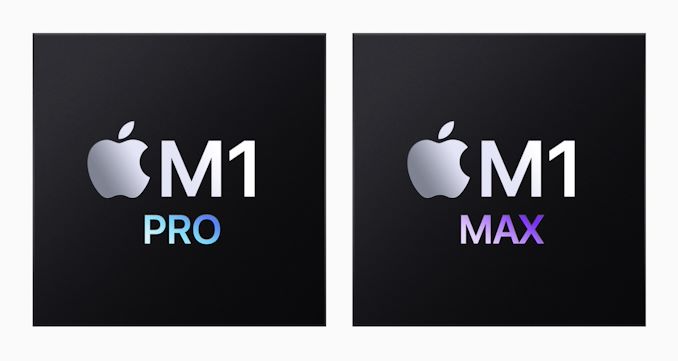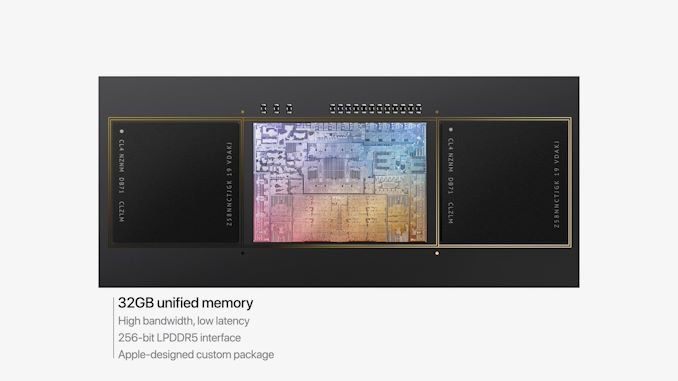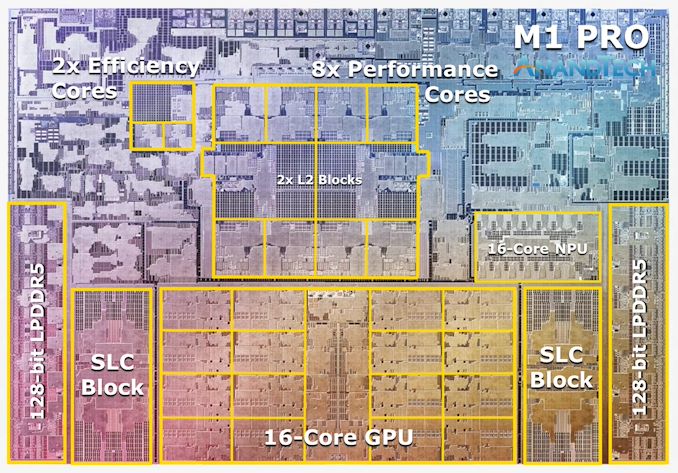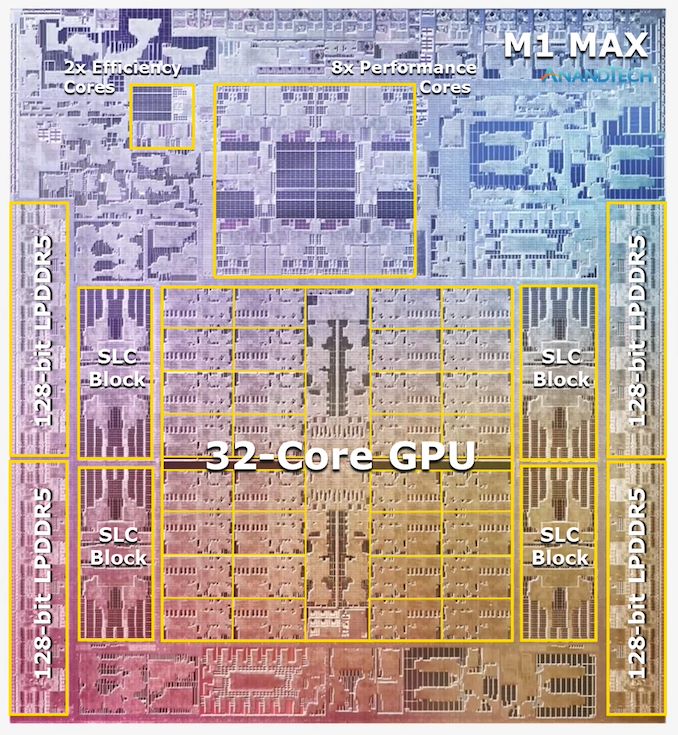Apple's M1 Pro, M1 Max SoCs Investigated: New Performance and Efficiency Heights
by Andrei Frumusanu on October 25, 2021 9:00 AM EST- Posted in
- Laptops
- Apple
- MacBook
- Apple M1 Pro
- Apple M1 Max

Last week, Apple had unveiled their new generation MacBook Pro laptop series, a new range of flagship devices that bring with them significant updates to the company’s professional and power-user oriented user-base. The new devices particularly differentiate themselves in that they’re now powered by two new additional entries in Apple’s own silicon line-up, the M1 Pro and the M1 Max. We’ve covered the initial reveal in last week’s overview article of the two new chips, and today we’re getting the first glimpses of the performance we’re expected to see off the new silicon.
The M1 Pro: 10-core CPU, 16-core GPU, 33.7bn Transistors
Starting off with the M1 Pro, the smaller sibling of the two, the design appears to be a new implementation of the first generation M1 chip, but this time designed from the ground up to scale up larger and to more performance. The M1 Pro in our view is the more interesting of the two designs, as it offers mostly everything that power users will deem generationally important in terms of upgrades.
At the heart of the SoC we find a new 10-core CPU setup, in a 8+2 configuration, with there being 8 performance Firestorm cores and 2 efficiency Icestorm cores. We had indicated in our initial coverage that it appears that Apple’s new M1 Pro and Max chips is using a similar, if not the same generation CPU IP as on the M1, rather than updating things to the newer generation cores that are being used in the A15. We seemingly can confirm this, as we’re seeing no apparent changes in the cores compared to what we’ve discovered on the M1 chips.
The CPU cores clock up to 3228MHz peak, however vary in frequency depending on how many cores are active within a cluster, clocking down to 3132 at 2, and 3036 MHz at 3 and 4 cores active. I say “per cluster”, because the 8 performance cores in the M1 Pro and M1 Max are indeed consisting of two 4-core clusters, both with their own 12MB L2 caches, and each being able to clock their CPUs independently from each other, so it’s actually possible to have four active cores in one cluster at 3036MHz and one active core in the other cluster running at 3.23GHz.
The two E-cores in the system clock at up to 2064MHz, and as opposed to the M1, there’s only two of them this time around, however, Apple still gives them their full 4MB of L2 cache, same as on the M1 and A-derivative chips.
One large feature of both chips is their much-increased memory bandwidth and interfaces – the M1 Pro features 256-bit LPDDR5 memory at 6400MT/s speeds, corresponding to 204GB/s bandwidth. This is significantly higher than the M1 at 68GB/s, and also generally higher than competitor laptop platforms which still rely on 128-bit interfaces.
We’ve been able to identify the “SLC”, or system level cache as we call it, to be falling in at 24MB for the M1 Pro, and 48MB on the M1 Max, a bit smaller than what we initially speculated, but makes sense given the SRAM die area – representing a 50% increase over the per-block SLC on the M1.
The M1 Max: A 32-Core GPU Monstrosity at 57bn Transistors
Above the M1 Pro we have Apple’s second new M1 chip, the M1 Max. The M1 Max is essentially identical to the M1 Pro in terms of architecture and in many of its functional blocks – but what sets the Max apart is that Apple has equipped it with much larger GPU and media encode/decode complexes. Overall, Apple has doubled the number of GPU cores and media blocks, giving the M1 Max virtually twice the GPU and media performance.
The GPU and memory interfaces of the chip are by far the most differentiated aspects of the chip, instead of a 16-core GPU, Apple doubles things up to a 32-core unit. On the M1 Max which we tested for today, the GPU is running at up to 1296MHz - quite fast for what we consider mobile IP, but still significantly slower than what we’ve seen from the conventional PC and console space where GPUs now can run up to around 2.5GHz.
Apple also doubles up on the memory interfaces, using a whopping 512-bit wide LPDDR5 memory subsystem – unheard of in an SoC and even rare amongst historical discrete GPU designs. This gives the chip a massive 408GB/s of bandwidth – how this bandwidth is accessible to the various IP blocks on the chip is one of the things we’ll be investigating today.
The memory controller caches are at 48MB in this chip, allowing for theoretically amplified memory bandwidth for various SoC blocks as well as reducing off-chip DRAM traffic, thus also reducing power and energy usage of the chip.
Apple’s die shot of the M1 Max was a bit weird initially in that we weren’t sure if it actually represents physical reality – especially on the bottom part of the chip we had noted that there appears to be a doubled up NPU – something Apple doesn’t officially disclose. A doubled up media engine makes sense as that’s part of the features of the chip, however until we can get a third-party die shot to confirm that this is indeed how the chip looks like, we’ll refrain from speculating further in this regard.














493 Comments
View All Comments
noone2 - Tuesday, October 26, 2021 - link
The laptop will be worthless and insanely outdated by the time and SSD dies, making it irrelevant even if that was the case.flyingpants265 - Sunday, October 31, 2021 - link
What an extremely dumb comment. Old Macbooks aren't worthless, they hold their value extremely well. If you use the Mac for what it's intended (video work) it's possible that you'll do damage to the drive.You really are an absolute idiot if you think there's an excuse for soldering SSDs. It's like welding in the suspension on your car because "the car will be worthless and outdated". No. They have a limited lifespan and need to be replaced when they die.
varase - Wednesday, November 3, 2021 - link
Then you take it in and have the logic board traded for a refurbished one, then restore your data.Anyone who doesn't take off-computer backups is an idiot and is deserves to lose data whether it sits on a HDD or SSD.
All drives fail eventually. I have at least two backups of everything, including my ginormous disk array. And when your replaceable SSD dies, it will take everything with it too.
coolfactor - Tuesday, October 26, 2021 - link
I'm typing this on a 2013 MacBook Air. 8 years and going strong. You chose "3000 writes" to sound dramatic, but that's the low end of low-end SSDs, none of which are used in Macs. SSDs can be rated up to 100,000 writes, and Samsung even promotes some of theirs as lasting 10 years under heavy usage. So your argument is weak, sorry.AshlayW - Tuesday, October 26, 2021 - link
Just as anecdotal as your emotional reply to defend your product/purchase decision. Look up Louis Rossmann on YT if you want to know what kind of company you are supporting.caribbeanblue - Saturday, October 30, 2021 - link
Unfortunately, these MacBooks are the best laptops on the market. Repairability is only part of the story, and the repairability of a device isn't just about ease of repair that is enabled by hardware design choices, it's also about the company providing board-level schematics to 3rd party repair shops, so users can have access to cost friendly genuine repair. Apple does have a long way to go in that aspect, that is true, however they *definitely* should not be forced to not solder down their SSD or DRAM. Soldering down such components earn you big improvements in terms of performance, energy efficiency, and space savings. If you want a laptop with a socketed RAM & removable SSD, then that's fine, buy something else, but don't act like MacBooks don't have any selling points, you would be delusional for thinking that.varase - Wednesday, November 3, 2021 - link
Louis Rossmann is a religious zealot.He's a repair gnome, not an innovator or designer.
UnNameless - Wednesday, November 17, 2021 - link
LR sadly became a jest! A joker filled with hate! I respected him a lot back in the days he mostly had content on repair stuff! I also agree with him about the Right to Repair and most of the issues regarding Mac stuff repairs! But his war for RtoR became a crusade and went nuts in the last year or so when he also started to bash Apple on software stuff and practically everything he can find awful! And I wouldn't have said nothing if he'd be an informant software guy, but he's an repair engineer, a good one and he should have sticked with that! From the fiascos with the Apple services and firewall whitelists, to the Apple OCSP so poorly misunderstood by him and even worse presented, to Apple hashing etc. Ever since he became a couch diva with that freaking cat, instead a shop repair guy...his true colors and hate towards just oozed so smoothly from his skin!RealAlexD - Monday, November 1, 2021 - link
3000 writes are actually a pretty good durability for a pro consumer SSD. While it is true, that some SSDs are rated for up to 100k writes, those are SLC devices, which are not really used anymore outside of special cases (Samsung Z-NAND). Normal SDDs will either have TLC or QLC Flash cells (or maybe 2bit MLC, but even Samsung Pro SSDs are now TLC), which don't last nearly as long.The TLC SSD with the most writes I could find was a Seagate Nytro Write intensive Server SSD, than promises about 20k writes.
Also conditions effect the number of writes a Flash cell will survive, here running warmer actually can increases lifetime. And the advertised durability is a worst case durability.
UnNameless - Wednesday, November 17, 2021 - link
I agree! Been using my iMac Pro from 2018 till present! Before I started earlier this year my little experiment with Chia plotting, which is known to burn up SSDs like nothing else, I had 99% lifetime drive left in my 1TB SSD. Even before I ran my experiment, I tried to search online to find what kind of nand flash the iMP uses but couldn't find any real concrete stuff as Apple has customs chips in those SSDs. So I took it for a spin and in the course of weeks I wrote in excess of 1PB of data! SSD lifetime dropped from 99% to 86%. If this scales linearly, I reckon you'd have to write in excess of 10PB of data on a 1TB SSD to bring it to critical levels or burn it completely! And I have never heard of anyone that does such a thing!